1 Integrated system approach
1.1 Background
Evolution of the QSE standards
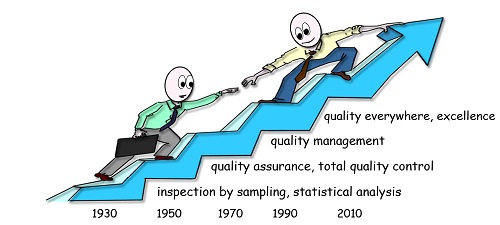
In most cases, an integrated management system has its origins in management systems related to:
- quality
- health and safety
- environment
The targets are different (productany outcome of a process or activity (see also ISO 9000, 3.4.2), personnel, environment), but complementary, as no company can do without one of the three elements.
Quality (Q)
Quality is anything that can be improved. Masaaki Imai
The evolution of the quality concept and the standards of quality management systemsset of processes allowing the achievement of the quality objectives (see also ISO 9000, 3.2.3) in industrial countries in the 20th century can be summarized as:
- quality control (till the 1980s) – quality practices, customers are (or seem) satisfied
- quality assurance (the 1990s) – the system is determined and implemented
- quality management (ISO 9000: 2000) – the system is controlled and its efficiency is improved
The technical committee "Management and quality assurance" (ISO/TC 176) within the ISOinternational organization for standardization (International Organization for Standardization) was created in 1980. ISOinternational organization for standardization itself was created in 1947. ISO comes from the Greek "isos" (equal).
The ISO 9000 standards (see figure 1-1) appeared in:
- 1987: first edition, based on the US military standard MIL-Q-9858 of 1959
- 1994: first revision, more understandable, customer focus better determined, preventive actions added
- 2000: second revision, simplified structure (8 clauses), priority to process approach and customer satisfaction
- 2008: third revision, clarification of the requirements (no new requirement), better alignment with ISO 14001
- 2015: fourth revision, new structure (high level), added risk-based thinking, performance becomes a priority, lightweight documentation
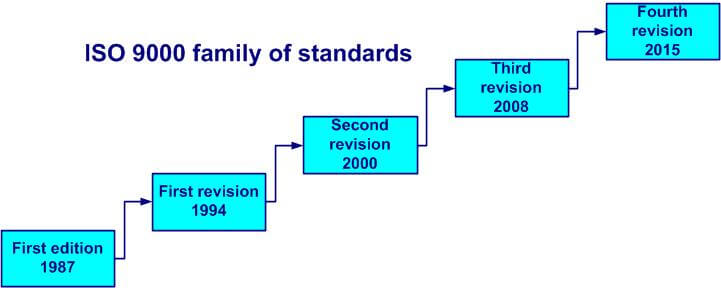
Figure 1-1. Revisions of ISO 9000 family
The three pillars of the ISO 9001 standard are:
- the process approach
- risk-based thinking
- continual improvement
The ISOinternational organization for standardization standards (more than 18,000) are used in countless fields and are recognized all over the world.
Health and safety (S)
The first laws relating to safety in France appear in the late nineteenth century.
In France the integration of occupational risk assessment (related to health and safety of workers) in the management of each company is an obligation of the Labour Code (R4121-1) since 2001.
The standard BS OHSAS 18001: 2007 is neither French nor an ISOinternational organization for standardization standard but was most commonly used for certifying health and safety worldwide. It is replaced by the ISO 45001 standard released in 2018.
Environment (E)
The first laws on environmental protection emerged in the 1970s.
The 2015 edition of ISO 14001 is distinguished by:
- new structure (high level)
- adding the risk-based thinking
- compatibility between environmental policy and strategic direction
- management fully assumes its responsibility (leadership) for the merformance of the environmetal management system (EMS)
The three pillars of sustainable development rest on the balance between:
- society
- environment and
- economy
The ISO 14001 environmental management system as the environmental pillar of sustainable development requires:
- compliance with regulations
- prevention of pollution
- a capacity to respond to emergencies
The prevention of pollution is a must for every responsible company.
1.2 Common concepts
Common QSE concepts
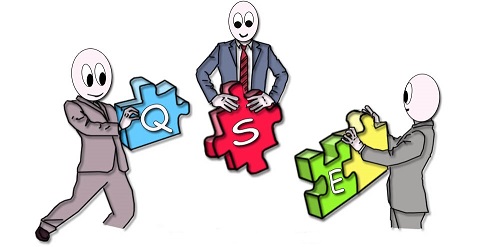
The three quality, safety and environment (QSEquality, safety, environment) management systems (see figure 1-2) share the following concepts:
- PDCA approach
- process approach
- context
- interested parties:
- needs
- expectations
- requirements
- risks
- satisfaction
- leadership of management
- commitments of management:
- policy
- objectives
- planning
- implementation
- communication and awareness
- resources
- management review
- control of documented information
- planning
- operational control
- performance evaluation:
- monitoring and measurement (inspection)
- internal audits
- prevention of:
- nonconformities
- accidents
- pollution
- continual improvement
During production, a productany outcome of a process or activity (see also ISO 9000, 3.4.2) may present risks to the health and safety of workers (QS) but also industrial risks of environmental pollution (SE).
When the productany outcome of a process or activity (see also ISO 9000, 3.4.2) cycle reaches the end of its life, it becomes waste and can present a risk and have an impact on the environment (EQ).
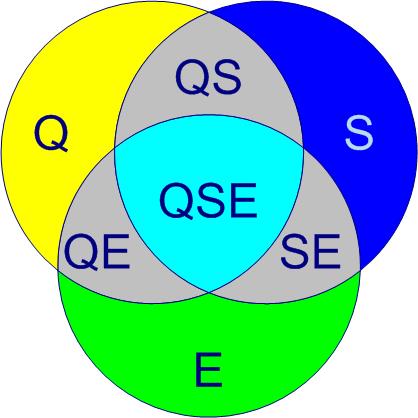
Figure 1-2. Common concepts QSE
Some similarities are specific to two management systems (QS, QE and SE) and strengthen the integration of the QSEquality, safety, environment systemset of interacting processes (see also ISO 9000, 3.2.1).
1.3 Principles, benefits and approach
Quality management principles, IMS preparation and implementation, Deming cycle

The seven quality management principles (cf. figure 1-3) will help us achieve sustained success (ISO 9000: 2015, sub-clause 2.3). Previously there were eight principles but now the system approach is integrated in the process approach.
.jpg)
Figure 1-3. The 7 quality management principles
The benefits of a QSE integrated management system include:
- the system is consistent
- management is optimized
- the documentation is without redundancies
- resoures are common
- costs are reduced
- prevention is widespread
- process performance is improved
- risks are better set and controlled
- improved image of the company
- confidence in the company is increased
- the satisfaction of all interested parties is better ensured
- commitment to sustainable development is real
A well-prepared approach is halfway to success
The approach to implementing an integrated QSEquality, safety, environment management system starts with preparation. An example is shown in figure 1-4.
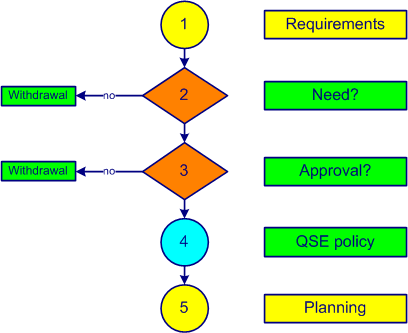
Figure 1-4. IMS preparation
Step one involves identifying the needs and expectations (requirementsexplicit or implicit need or expectation (see also ISO 9000, 3.1.2)) of interested parties:
- staff
- customers, consumers
- competitors
- shareholders, investors
- external providers (suppliers, subcontractors, partners)
- organizations and branch associations
- statutory and regulatory authorities
The involvement of top management at its highest level is truly indispensable. The advice of a consultant is often solicited. Determining the current status of the management system (whole or partial) would be welcome at this stage. An external certification body is chosen.
One of the key questions that comes up quickly (step 2) is the need for this decision. If this is not really necessary or if the estimated costs of the certification approach exceed the available resources, it is better to reject this idea immediately.
The ISO 9000 family of standards will stop you making promises you can't fulfil and help you keep those you can. David Hoyle
The benefits of implementing an integrated QSEquality, safety, environment management system are often:
- an improved image of the organization
- being one step ahead of competition
- environmental protection reinforced
- environmental performance evaluated and communicated
- increased safety of staff
- reduction of production costs
- reducing or eliminating incidents
- better preparation for emergencies
- anticipating sustainable development
- increased confidence and satisfaction of stakeholders
- the prevention of pollution, hazards and risks becoming routine
- better economic results
- reduced energy consumption
- increased daily effectiveness
- staff who are aware, consulted, motivated and proud
- high level of risk control
- reduced insurance costs
- commitment profitable for all
- good practices are valorized
- standardization of know how
- control of processes
- updated legal obligations
The benefits of the certification of an integrated QSEquality, safety, environment management system are often:
- new customers
- increased market share
- an increase in sales
- better financial performance
More than one and a half million businesses worldwide can not be wrong!
Motorola used ISO 9001 to reduce production costs and improve the efficiency of its processes. Streamlining operations has eliminated waste and reduced cycle times.
Motorola has recorded substantial savings, demonstrating the positive impact of ISO 9001 on financial performance. This certification allowed the company to stand out from the competition and access new markets.
IBM, one of the world leaders in information technology, has implemented ISO 45001 to improve the management of stress and psychosocial risks at work. Implementing prevention and support measures for employees has helped reduce stress and improve well-being at work.
IBM has recorded a significant improvement in the mental health of its employees, demonstrating the importance of addressing psychosocial risks and the company's commitment to the well-being of its employees.
Coca-Cola implemented ISO 14001 to reduce its water consumption and improve its environmental efficiency. The implementation of water-saving technologies and employee awareness programs has significantly reduced water consumption.
Coca-Cola has recorded substantial savings, demonstrating the positive impact of ISO 14001 on financial performance and its commitment to sustainability.
The internalization of the spirit of the principles and requirementsexplicit or implicit need or expectation (see also ISO 9000, 3.1.2) of QSEquality, safety, environment standards significantly improves the overall performance of your business, especially when it is not considered as a constraint.
The third step shall determine whether this approach receives the approval of the staff. A communication campaign is launched in-house on the objectives of an integrated management system (IMSintegrated management system). The staff is aware and understands that, without their participation, the project cannot succeed.
Have confidence: success will come with the involvement and effort of all!
The vision (what we want to be), the mission (why we exist) and the business plan of the company are set. The following step (4) includes the establishment of an outline of the QSEquality, safety, environment policy and quality objectives. If you do not have a copy of the ISO 9001, OHSAS 18001 and ISO 14001 standards, now is the time to get them (see sub-clause 2.1 of the present course).
Planning is the last step (5) of the project preparation for obtaining QSEquality, safety, environment certification. A reasonable period is between 6 to 12 months (each company is unique and specific). A management representative is appointed as project leader. Top management commitment is formalized in a document communicated to all staff. A person is appointed as project leader for obtaining certification.
The establishment and implementation of an integrated management system are shown in figure 1-5.
.jpg)
Figure 1-5. IMS implementation
Step 1 aims to determine the processes, interactions, owners, responsibilities. Drafts of certain documented information are established. Needs, expectations and requirementsexplicit or implicit need or expectation (see also ISO 9000, 3.1.2) of all interested parties are analysed. The first versions of different documented information (job descriptions, documented information to maintain, work instructions, processactivities which transform inputs into outputs (see also ISO 9000, 3.4.1) sheets) are written with the participation of the maximum number of available persons.
In step 2 the necessary resources to achieve the QSEquality, safety, environment objectives are set. Planning tasks, responsibilities and time frames are established. Internal staff and subcontractors are aware of potential hazards and environmental impacts. Training of internal auditors is taken into account.
Step 3 allows you to set and implement methods for measuring the effectiveness and efficiency of each processactivities which transform inputs into outputs (see also ISO 9000, 3.4.1) (indicators). Internal audits help to evaluate the degree of implementation of the systemset of interacting processes (see also ISO 9000, 3.2.1) (customeranyone who receives a product (see also ISO 9000, 3.3.5) requirementsexplicit or implicit need or expectation (see also ISO 9000, 3.1.2), hazard identification, risk assessment, identification of environmental aspects and impacts, legal and other requirementsexplicit or implicit need or expectation (see also ISO 9000, 3.1.2)).
Nonconformities of all kinds are listed in step 4. A first draft for dealing with waste is established. A sorting out of corrective actions is introduced. Emergencies with potential impacts on health, safety and environment are listed. The responses (action and reaction) to emergencies are put in place and documented.
A first encounter with the tools and application areas of continual improvementpermanent process allowing the improvement of the global performance of the organization (see also ISO 9000, 3.2.13 and ISO 14 001, 3.2) is made in step 5. A table with the main costs of obtaining quality (COQcosts of obtaining quality) is filled in by people with the information at hand. Risks are determined, actions are planned and improvement opportunities are taken. An approach to preventing nonconformities and eliminating causes is established. The activities associated with determined hazards and significant environmental aspects, are planned and implemented. A legal watch is undertaken. The risk assessment document is developed. Communication is established and formalized internally and externally.
To conduct the pre-audit of the IMSintegrated management system (step 6), documented information is checked and approved by the appropriate people. A management review allows evaluating whether applicable requirementsexplicit or implicit need or expectation (see also ISO 9000, 3.1.2) are met. The QSEquality, safety, environment policy and objectives are finalized. A QSEquality, safety, environment manager from another company or a consultant can provide valuable feedback, suggestions and recommendations.
When the systemset of interacting processes (see also ISO 9000, 3.2.1) is accurately implemented and followed, the certification of the IMSintegrated management system by an external body is a breeze, a formality (step 7).
An example of a certification project plan with 28 steps is shown in annex 01. 
An appropriate method for evaluating the performance of your integrated management system is the RADAR logic model of excellence EFQM (European Foundation for Quality Management), with its nine criteria and overall score of 1000 points.
The Deming cycle (figure 1-6) is applied to control any processactivities which transform inputs into outputs (see also ISO 9000, 3.4.1). The PDCA cycles (Plan, Do, Check, Act) are a universal base for continual improvementpermanent process allowing the improvement of the global performance of the organization (see also ISO 9000, 3.2.13 and ISO 14 001, 3.2).
.jpg)
Figure 1-6. Deming cycle
- Plan – prepare, define context, issues and processes, establish policies and objectives and demonstarte leadership (clauses 4, 5 and 6)
- Do – develop and implement processes, demonstrate leadership, control life cycle, bring support and respond to emergencies (clauses 5, 7 and 8)
- Check – understand, inspect, analyze data, demonstrate leadership, conduct audits and management reviews (clauses 5 and 9)
- Act – adapt, decide, demonstrate leadership, treat nonconformities, react with corrective actions or find new improvements (new PDCA cycle), (clauses 5 and 10)
For more information on the Deming cycle and its 14 points of management theory, you can consult the classic book "Out of the crisis", W. Edwards Deming, MIT press, 1982.
